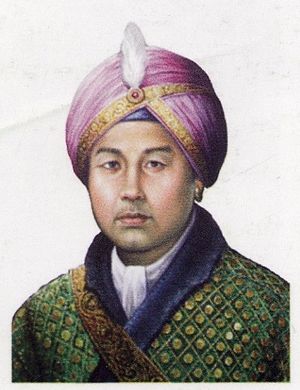- Chinglen Nongdrenkhomba
-
Chinglen Nongdrenkhomaba Gambhir Singh 
Portrait by RKCS King of Manipur (more...) Reign April 1821 to October 1821 and 12 June 1825 [1] to 9 January 1834 Coronation 6 June 1831[2] Predecessor Badra Singh, father of Maharaja Nara Singh Successor Chandra kriti Consort Meetei Leima Maipung Lanthabi, Meetei Leima Maisnam Kumudini Issue Chandra Kirti ( also known as Ningthem Pisak), Princess Shija Tamphasana, Prince Ibungshija Raj Singh House Ningthouja Dynasty Royal family of Manipur Father Chingthang Khomba Mother Queen Khumong Mayum Chanu Born 5 March 1788
Langthabal Palace, CanchipurDied 9 January 1834 (aged 47)
Langthabal Palace, CanchipurChinglen Nongdrenkhomba (1788-1834), also known as Maharaja Gambhir Singh, was a son of Chingthang Khomba. He succeeded his nephew Yumjaotaba in April 1821 during the seven years devastation. He abdicated the throne with the arrival of a Burmese force under his cousin Prince Jai Singh,the firt puppet king of Manipur under Burmese suzerainty[3] , in October 1821. Gambhir Singh fled to Cachar. In Cachar, Gambhir Singh with the help of his elder brothers Chourjit and Marjit dethroned Govinda Chandra, the king of Cachar. Govinda Chandra applied for the protection of the British East India Company. His request was refused. In consequence of which he applied to the King of Burma to reinstate him. Accordingly in 1823 the king of Burma send a large army into Cachar from to arrest Chourjit, Marjit and Gambhir Singh. The Burmese forces proceeded upto the territory of British East India Company. In March 1824, Lord Amherst, the then Governor General of British India declared war against Burma. In 1823, the British Government opened communications with Gambhir Singh; upon which 500 Manipuris under his command were taken into pay of the British Government, and co-operated with the British troops in driving out the Burmese out of Cachar.[4] This force of 500 men was known as Gambhir Singh Levy (later Manipur Levy). The Manipur Levy under Gambhir Singh and his second cousin Nara Singh, later Maharaja Nara Singh, played a key role in driving out the Burmese from cachar and Manipur. The First Anglo-Burmese War was ended with the defeat of the Burmese. A peace treaty was signed between the Burmese and the British on 24 February, 1826 known as the Treaty of Yandaboo[5] . According to the article no.2 of the Treaty Gambhir Singh was declared the independent ruler of Manipur. Gambhir Singh reigned until his death on 9 January 1834. He was succeeded by his infant son Chandra Kriti with Maharaja Nara Singh as regent.[6]
References
- ^ Rajkumar, Somorjit Sana (2010). The Chronology of Meetei Monarchs ( From 1666 CE to 1850 CE). Imphal: Waikhom Ananda Meetei. pp. 272. ISBN 978-81-8465-210-9.
- ^ Raj Kumar, Somorjit Sana. pp. 286.
- ^ Kabui, Gangmumei (1991). History of Manipur, vol.I. New Delhi: National Publishing House. pp. 291. ISBN 81-214-0362-6.
- ^ Mackenzie, A (1884). History of Relations of Government with the Hill tribes of North east Frontier of British India. Calcutta.
- ^ Aichison, C.U (1931). Treaties, Sanads, Engagements, etc. Reprint Delhi (1979): Craus Thomson Organisation.
- ^ R.K., Jhalajit (1992). A Short History of Manipur. Imphal. pp. 259-260.
External links
- Modern Era[dead link] - IIT Guwahati
- Restoration work gets under way at the historic Kangla Fort in Manipur.[dead link] Frontline - Sep 09, 2005
Categories:- Meitei royals
- Hindu monarchs
- 1789 births
- 1829 deaths
- Indian royalty stubs
Wikimedia Foundation. 2010.
